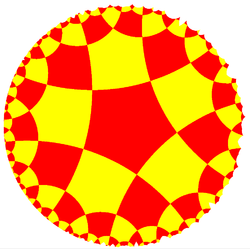- Dodecadodecahedron
-
Dodecadodecahedron 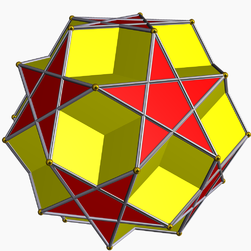
Type Uniform star polyhedron Elements F = 24, E = 60
V = 30 (χ = −6)Faces by sides 12{5}+12{5/2} Wythoff symbol 2 | 5 5/2 Symmetry group Ih, [5,3], *532 Index references U36, C45, W73 
5.5/2.5.5/2
(Vertex figure)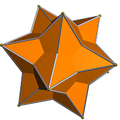
Medial rhombic triacontahedron
(dual polyhedron)In geometry, the dodecadodecahedron is a nonconvex uniform polyhedron, indexed as U36. It is given a Schläfli symbol t1{5/2,5}.
The Dodecadodecahedron has 30 vertices, 60 edges, and 24 faces (12{5}+12{5/2}). The vertex configuration is 5.5/2.5.5/2. Its symmetry group is Ih, [5,3], *532, its Wythoff symbol is 2 | 5 5/2, and its Euler characteristic is χ=−6.
Its uniform index number is U36, its Kaleido index is K41, its number in Wenninger's Polyhedron Models is 73, and it was given the number 45 in Coxeter's 1954 paper, which first gave the complete list of the uniform polyhedra.
Contents
Net
A shape with the same exterior appearance as the dodecadodecahedron can be constructed by folding up these nets:
12 pentagrams and 20 rhombic clusters are necessary. However, this construction replaces the crossing pentagonal faces of the dodecadodecahedron with non-crossing sets of rhombs, so it does not produce the same internal structure.
Related polyhedra
Its convex hull is the icosidodecahedron. It also shares its edge arrangement with the small dodecahemicosahedron (having the pentagrammic faces in common), and with the great dodecahemicosahedron (having the pentagonal faces in common).
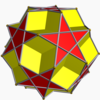
Dodecadodecahedron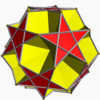
Small dodecahemicosahedron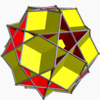
Great dodecahemicosahedron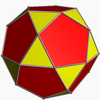
Icosidodecahedron (convex hull)This polyhedron can be considered a rectified great dodecahedron. It is center of a truncation sequence between a small stellated dodecahedron and great dodecahedron:
The truncated small stellated dodecahedron looks like a dodecahedron on the surface, but it has 24 faces: 12 pentagons from the truncated vertices and 12 overlapping as (truncated pentagrams). The truncation of the dodecadodecahedron itself is not uniform, but it has a uniform quasitruncation, the truncated dodecadodecahedron.
Name Small stellated dodecahedron Truncated small stellated dodecahedron Dodecadodecahedron Truncated
great
dodecahedronGreat
dodecahedronCoxeter-Dynkin
diagram


































Picture 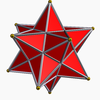
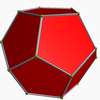

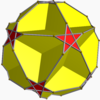

It is topologically equivalent to a quotient space of the hyperbolic order-4 pentagonal tiling, by distorting the pentagrams back into regular pentagons. As such, it is topologically a regular polyhedron of index two:[1][2]
The colours in the above image correspond to the red pentagrams and yellow pentagons of the dodecadodecahedron at the top of this article.
See also
References
- ^ The Regular Polyhedra (of index two), David A. Richter
- ^ The Golay Code on the Dodecadodecahedron, David A. Richter
External links
Star-polyhedra navigator Kepler-Poinsot polyhedra
(Nonconvex regular polyhedra)Uniform truncations of Kepler-Poinsot polyhedra Nonconvex uniform Hemipolyhedra Duals of nonconvex uniform polyhedra medial rhombic triacontahedron · small stellapentakis dodecahedron · medial deltoidal hexecontahedron · small rhombidodecacron · medial pentagonal hexecontahedron · medial disdyakis triacontahedron · great rhombic triacontahedron · great stellapentakis dodecahedron · great deltoidal hexecontahedron · great disdyakis triacontahedron · great pentagonal hexecontahedronDuals of Nonconvex uniform
(Infinite stellations)tetrahemihexacron · hexahemioctacron · octahemioctacron · small dodecahemidodecacron · small icosihemidodecacron · great dodecahemidodecacron · great icosihemidodecacron · great dodecahemicosacron · small dodecahemicosacron
This polyhedron-related article is a stub. You can help Wikipedia by expanding it.


